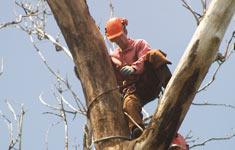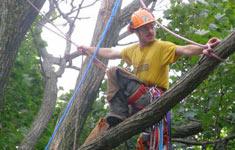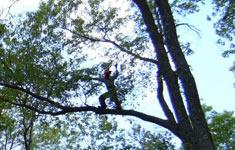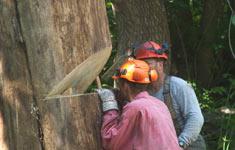Tree pruning FAQs
Will pruning the tree hurt it?
It depends on the tree species and the size of the pruning cut... just like humans, trees have evolved with biological responses to wounds that help protect from infection and decay. Trees are well equipped to close small wounds as most or all of the tissue that is exposed by the pruning cut is live / active vascular tissue. However, trees cannot protect themselves well from large wounds because the innermost tissues are not biologically active like the outer growth rings and, as such, cannot create the wound wood needed to cover over the cut. Neither can these tissues fend off decay causing bacteria nearly as well as the active growth rings can. So, more often than not, the tree will not be able to close over a large wound before decay has set in. This can be the first step in a long process that can lead to the tree's eventual demise. As a rule, softwood trees such as Pines have a thicker layer of active growth rings than hardwoods and can therefore more effectively close larger wounds. Given these factors, we discourage removal of limbs over 3" diameter in hardwoods and 5" diameter in softwoods unless it is necessary to remove a hazardous condition.
Shouldn't the pruning cuts be painted / treated?
Studies have shown that treating a tree wound does not help the tree and can actually accellerate decay. The thought is that the treatment will hold moisture against the wound and, like on human wounds, create an ideal environment for the decay causing bacteria to grow. So, as a rule, it is best to leave the wounds untreated and keep them as dry as possible, allowing the tree's natural responses to do what they've done for millions of years.
Is there a wrong or right time of year to prune?
The old saying goes... "The best time to prune a tree is when you have the time." The unspoken wisdom in that saying is that trees are very resilient and can handle pruning whenever it is done. That said, there are always exceptions and the main two are that pruning during the flowering and fruiting stages of fruit trees is discouraged because one will inevitably knock blossoms and fruit off during the pruning process, thereby reducing fruit production. The other exception is that a select few tree species are vulnerable to bacteria that are only active at certain times of year, so those trees should not be trimmed during those times.
It depends on the tree species and the size of the pruning cut... just like humans, trees have evolved with biological responses to wounds that help protect from infection and decay. Trees are well equipped to close small wounds as most or all of the tissue that is exposed by the pruning cut is live / active vascular tissue. However, trees cannot protect themselves well from large wounds because the innermost tissues are not biologically active like the outer growth rings and, as such, cannot create the wound wood needed to cover over the cut. Neither can these tissues fend off decay causing bacteria nearly as well as the active growth rings can. So, more often than not, the tree will not be able to close over a large wound before decay has set in. This can be the first step in a long process that can lead to the tree's eventual demise. As a rule, softwood trees such as Pines have a thicker layer of active growth rings than hardwoods and can therefore more effectively close larger wounds. Given these factors, we discourage removal of limbs over 3" diameter in hardwoods and 5" diameter in softwoods unless it is necessary to remove a hazardous condition.
Shouldn't the pruning cuts be painted / treated?
Studies have shown that treating a tree wound does not help the tree and can actually accellerate decay. The thought is that the treatment will hold moisture against the wound and, like on human wounds, create an ideal environment for the decay causing bacteria to grow. So, as a rule, it is best to leave the wounds untreated and keep them as dry as possible, allowing the tree's natural responses to do what they've done for millions of years.
Is there a wrong or right time of year to prune?
The old saying goes... "The best time to prune a tree is when you have the time." The unspoken wisdom in that saying is that trees are very resilient and can handle pruning whenever it is done. That said, there are always exceptions and the main two are that pruning during the flowering and fruiting stages of fruit trees is discouraged because one will inevitably knock blossoms and fruit off during the pruning process, thereby reducing fruit production. The other exception is that a select few tree species are vulnerable to bacteria that are only active at certain times of year, so those trees should not be trimmed during those times.




